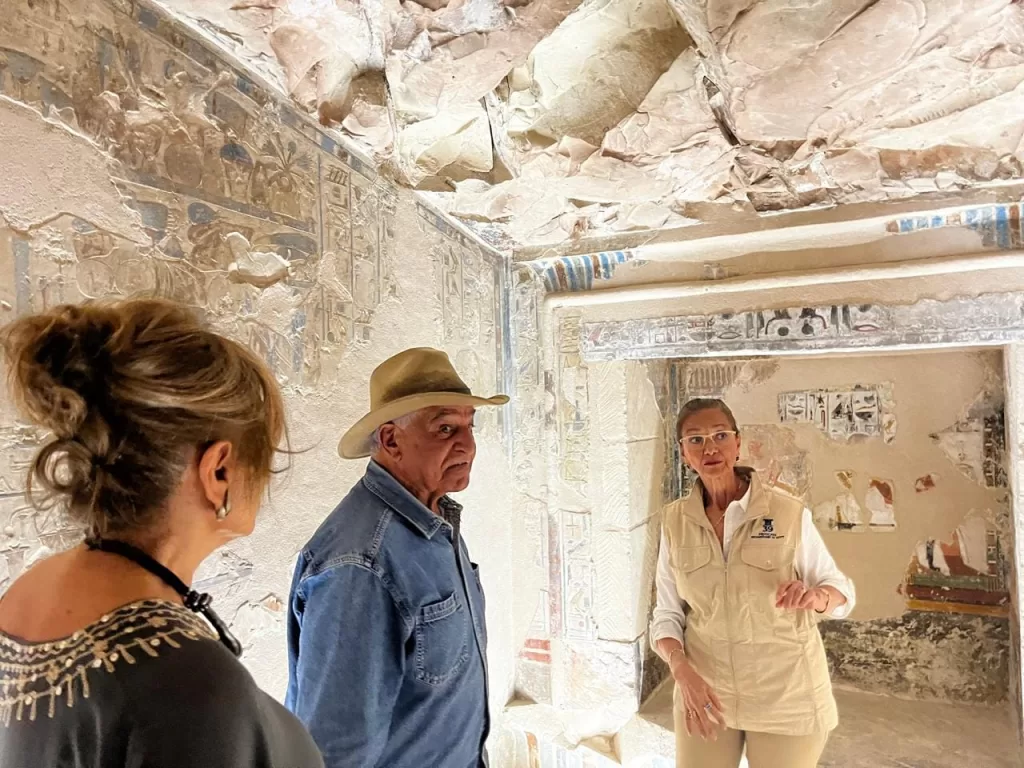After two decades of unwavering dedication, meticulous consolidation, and expert restoration, a remarkable chapter in archaeological history unfolded in Luxor as the Mexican Archaeological Mission officially handed over Theban Tomb 39 (TT39) to Egypt’s Tourism and Antiquities Ministry.
This milestone event marked a profound achievement in the preservation of some of the most culturally significant yet previously unrestored burial chambers in Egypt.
Under the leadership of renowned Egyptologist Gabriela Arrache, the tomb now opens its doors to the public, inviting visitors to immerse themselves in the mesmerising world of ancient Egypt.
Theban Tomb 39, belonging to Puimre, a revered priest of Amon during the illustrious 18th Dynasty, dazzles as a shimmering testament to the splendour of Egyptian funerary art.
Last week, a distinguished gathering graced the unveiling ceremony, including the Ambassador of Mexico, Leonora Rueda, and celebrated archaeologist Zahi Hawass.

“Thanks to the joint work of Mexican and Egyptian archaeologists, restorers and workers, this site will be preserved for future generations,” Ambassador Rueda said.
“The project strengthens the bonds of friendship and collaboration between Mexico and Egypt, highlighting the global dedication to safeguarding humanity’s cultural heritage,” she added.
She remarked that both Egyptians and Mexicans are descendants of ancient civilisations, connected through shared beliefs that mirror those of the ancient Egyptians, albeit under different names.

Hawass, speaking about the condition of the tomb before restoration, revealed that it was on the brink of collapse and loss.
“In 2005, I urged the Mexican mission, and they rose to the occasion with exceptional dedication,” he told The Egyptian Gazette.
“Fallen inscriptions were meticulously repositioned, while the burial chamber and its vibrant wall scenes were restored to their original glory,” he elaborated.
Hawass emphasised that it is usually more crucial for international missions to focus on restoration rather than excavation.
Nestled in El-Khokha, part of the vast Theban Necropolis on the Nile’s west bank, TT39 stands as the final resting place of Puimre. His life and work spanned the reign of Queen Hatshepsut and Thutmosis III (circa 1478 – 1500 B.C.).

The tomb is a unique architectural marvel, deviating from typical T-shaped tombs by featuring a columned portico and a transverse hall leading to three intricately decorated chapels.
Each chapel, rich in symbolism, reflects distinct scenes from Puimre’s life, honouring his significance, his family, and the customs of his time.
The courtyard of TT39, not only showcases elaborate decorative elements, but also features false doors at regular intervals and rounded tablets, all characterised by a slight backward tilt and inscribed with monochrome engravings.
The hallway leading to the three chapels depicts various scenes, including inspections of the Temple of Amun’s workshops and activities, such as carpentry, jewellery making, stone-vase crafting, and ploughing. It also illustrates attendants managing horses and chariots.


Guests and female musicians, along with women playing the lyre, are depicted, representing the wealth and resources from southern lands offered to the Treasuries of Amun.
Among these offerings are Nubians with cattle, gold, and ivory, alongside monkeys and baboons, and Egyptians with fine linen.
The archaeological team thoroughly examined the tomb, assessing damage and crafting a conservation strategy, while planning the stages of restoration. Its members also conducted an epigraphic study.
Furthermore, the team strengthened and repaired the adorned walls, ceilings, and vaults, and worked on restoring the bas-relief carvings.
In Tomb TT39, scenes featuring an offering procession were depicted exclusively in the southern chapel, aligning with the array of gifts offered to the departed.
By integrating modern technology into their architectural and epigraphic assessments, the members of the team employed 3D laser scanning to better understand the decay process and create a foundation for future studies.
The team facilitated the development of a cultural and educational programme, which included both printed and digital materials derived from the 3D survey data.
Using the BLK360 imaging laser scanner and Cyclone 3D point cloud processing software, they meticulously captured every detail of the walls and vaults.
The comprehensive point clouds enabled an in-depth analysis of the paintings, engraved epigraphy, and the intricate architecture within the funerary chambers.
The wall carvings and paintings illustrating the priest’s life are invaluable in helping researchers piece together aspects of ancient life, craftsmanship, and cultural practices, while also preserving these elements digitally.
Digital databases were created to compile point clouds and spherical images, which included floor plans, 3D models, and architectural diagrams.
Additionally, missing sections of the walls, vaults, and any structural cracks were documented for future reconstruction and research.






Discussion about this post